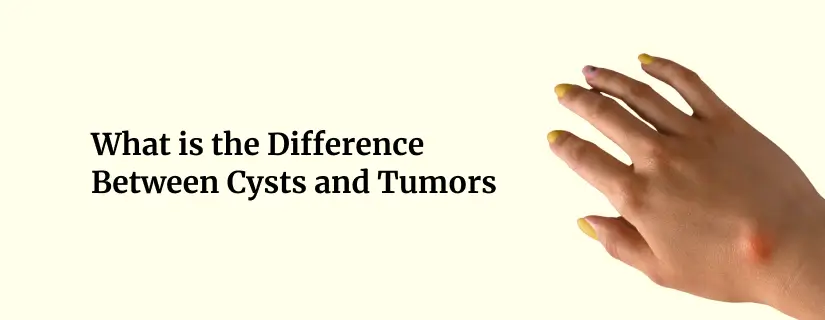-
Doctors
-
Specialities & Treatments
Centre of Excellence
Specialties
Treatments and Procedures
Hospitals & Directions HyderabadCARE Hospitals, Banjara Hills CARE Outpatient Centre, Banjara Hills CARE Hospitals, HITEC City CARE Hospitals, Nampally Gurunanak CARE Hospitals, Musheerabad CARE Hospitals Outpatient Centre, HITEC City CARE Hospitals, Malakpet
HyderabadCARE Hospitals, Banjara Hills CARE Outpatient Centre, Banjara Hills CARE Hospitals, HITEC City CARE Hospitals, Nampally Gurunanak CARE Hospitals, Musheerabad CARE Hospitals Outpatient Centre, HITEC City CARE Hospitals, Malakpet Raipur
Raipur
 Bhubaneswar
Bhubaneswar Visakhapatnam
Visakhapatnam
 Nagpur
Nagpur
 Indore
Indore
 Chh. Sambhajinagar
Chh. SambhajinagarClinics & Medical Centers
Book an AppointmentContact Us
Online Lab Reports
Book an Appointment
Consult Super-Specialist Doctors at CARE Hospitals
What is the Difference Between Cysts and Tumors
Updated on 1 October 2024

Have you ever noticed a lump under your skin and wondered what it might be? Understanding the differences between cysts and tumours can help ease your mind and guide you towards appropriate medical care. These two types of growths, while sometimes similar in appearance, have distinct characteristics that set them apart.
This comprehensive guide uncovers the key aspects of cyst and tumour differences. We'll delve into the conditions that cause each type of growth, helping you recognise when it's time to seek medical advice.
Differences Between Cysts and Tumours
Cysts and tumours are two distinct types of growths that can occur in the body. A cyst is a closed, sac-like tissue pocket filled with fluid, air, or other substances. They form when something blocks a gland or bodily drainage, causing material build-up. Cysts can develop at any place inside the body and are usually benign.
On the other hand, tumours are solid masses of abnormal cells that grow uncontrollably. They can be benign, premalignant, or malignant. Benign tumours stay localised, while malignant tumours can spread to other body parts.
The key difference lies in their composition & behaviour. Cysts are fluid-filled sacs, while tumours are solid masses of tissue. Cysts are typically benign and may require drainage or removal if they cause discomfort. Tumours, especially malignant ones, often need more aggressive treatment due to their potential to spread and impact surrounding tissues.
Conditions that Cause Cysts
Cysts can develop due to various conditions, such as:
- Infection: Sometimes, during bacterial or viral infection, our body tries to isolate the infection, resulting in cyst development.
- Chronic Inflammation: Long-term illnesses, such as rheumatoid arthritis or lupus, may result in cyst formation in different body parts.
- Hormonal Imbalance: Conditions that cause hormonal changes, such as polycystic ovary syndrome (PCOS), can lead to ovarian cysts.
- Duct Blockage: Sudden obstruction of the ducts or glands, like the sebaceous or Bartholin's glands, can lead to cysts when the fluid cannot escape.
- Genetic Condition: Certain inherited conditions, such as Gardner's syndrome or autosomal dominant polycystic kidney disease, result in cysts development in various organs.
Conditions that Cause Tumours
Tumours may be benign or malignant, with the latter being cancerous and capable of spreading to other body parts. Tumours develop when cells grow and divide uncontrollably. This abnormal growth can result from various conditions, including:
- Genetic Mutations: Mutations in genes such as BRCA1 & BRCA2 increase the risk of tumours, especially breast and ovarian cancers.
- Family History: Certain tumours, such as Lynch syndrome or familial adenomatous polyposis, tend to run in families.
- Carcinogen Exposure: Exposure to harmful chemicals, such as asbestos, tobacco smoke, or pesticides, increases the risk of lung, bladder, or skin tumours.
- Certain Infections: Certain viral infections, such as human papillomavirus (HPV) or hepatitis B/C, are associated with cervical or liver tumours, respectively.
- Radiation Exposure: Prolonged exposure to ionising radiation can cause cell mutations, resulting in tumour development.
- Chronic Conditions: Long-term inflammatory conditions, such as ulcerative colitis or Crohn's disease, can increase the predisposition to GI tumours.
- Immune System Dysfunction: People with compromised immunity, such as those with HIV/AIDS or organ transplants, are more prone to tumours like Kaposi's sarcoma or lymphoma.
- Hormonal discrepancy: Hormonal imbalance or excess, such as growth hormone or estrogen, may stimulate cancerous cell development, especially in the breast, uterus, or prostate.
When to See a Doctor?
While most cysts and tumours are benign, it's crucial to have them evaluated by a specialist. Individuals should consult their doctors immediately if they notice a lump that grows quickly, changes colour, appears red or swollen, bleeds, causes pain or interferes with daily activities. Prompt medical evaluation is one of the most important aspects of proper diagnosis and treatment.
Doctors use various methods to determine the nature of a mass. Ultrasounds and CT scans often help visualise the growth. A doctor may use a needle to aspirate some liquid to test if the lump contains fluid. Sometimes, a biopsy or complete surgical removal may be necessary for diagnosis. A pathologist then examines the cells to determine their type and whether they are benign, malignant, or precancerous.
Conclusion
Understanding the differences between cysts and tumours is crucial for recognising potential health concerns. Both can appear as lumps under the skin, but their composition and behaviour set them apart. Cysts are typically benign, fluid-filled sacs, while tumours are solid masses of abnormal cells that can be benign or malignant. Knowing these distinctions can help individuals seek timely medical attention when needed.
Regular check-ups and prompt medical evaluation of unusual growths are key to maintaining good health. While many cysts and tumours are harmless, some may require treatment or further investigation. By staying informed and attentive to bodily changes, individuals can know about any abnormal changes and take an active role in their health care. This knowledge can help them to make informed decisions about their well-being and to seek appropriate medical advice when necessary.

ENQUIRY FORM
SELECT CATEGORIES
-
Neurosciences (16)
-
Neurology (37)
-
Neurosurgery (14)
-
Orthopaedics (48)
-
Oncology (33)
-
Obstetrics and gynecology (51)
-
Pulmonology (23)
-
Urology (20)
-
Nephrology (13)
-
Psychiatry (7)
-
Dietetics and Nutrition (111)
-
General Medicine (63)
-
Cardiac Sciences (30)
-
Vascular & Endovascular Surgery and Interventional Radiology (10)
-
Gastroenterology (46)
-
Endocrinology (23)
-
Plastic Surgery (10)
-
Critical Care Medicine (5)
-
COVID-19 (16)
-
Dermatology (16)
-
Emergency Care (1)
-
Ophthalmology (4)
-
Pediatrics (14)
-
Laparoscopic and Bariatric Surgery (8)
-
ENT (15)
-
Kidney Transplant (1)
-
Liver Transplantation and Hepatobiliary Surgery (5)
-
General Surgery (3)
-
Internal Medicine (5)
-
Medicine Information
Difference Between Piles, Fissures, and Fistula
RECENT BLOGS
-

Direct Anterior Approach in Total Hip Replacement: Advantages and Challenges
10 April 2025
Read More
-

Zinc Deficiency: Signs and Symptoms, Causes, Treatment
9 April 2025
Read More
-

Chest Pain When Coughing: Causes, Treatment and Home Remedies
9 April 2025
Read More
-

12 Health Benefits of Eating Mushrooms
8 April 2025
Read More
-

7 Health Benefits of Blood Donation You Should Know About
8 April 2025
Read More
-

Implantation Bleeding Vs Periods: Know the Difference
28 February 2025
Read More
-

Bloating During Ovulation: Symptoms, Causes and Remedies
28 February 2025
Read More
-

Itching During Dengue: Causes, Treatment and Home Remedies
18 February 2025
Read More
Have a Question?
If you cannot find answers to your queries, please fill out the enquiry form or call the number below. We will contact you shortly.


